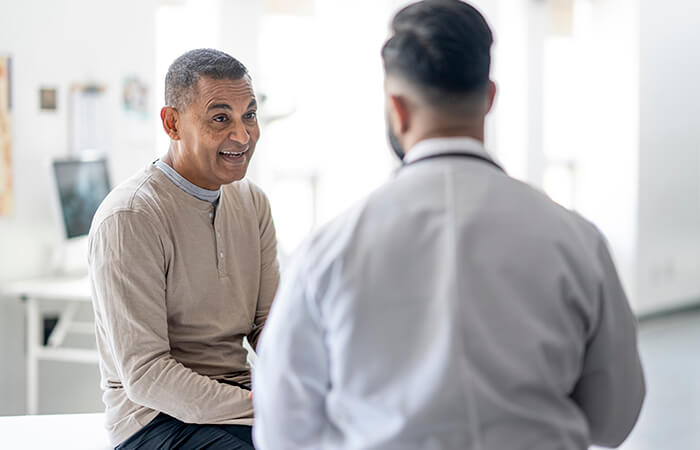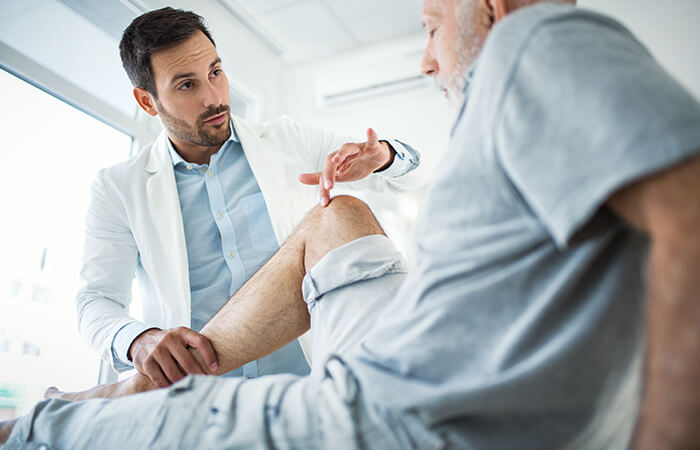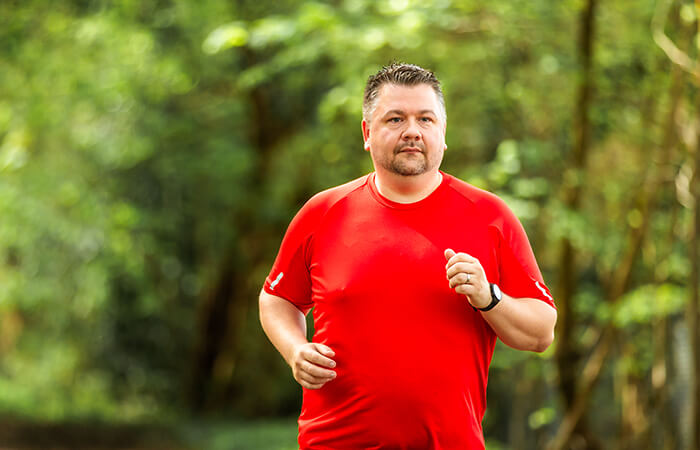Do you have knee pain or an orthopedic surgery coming up? You may be wondering what surgery could look like to fix your muscle, bone or joint condition.
These 3D animations shown here are just some of those used by our orthopedic specialists and can assist you in better understanding your condition or procedure. These interactive videos are meant to provide a general, educational overview and each patient’s situation is unique. We look forward to answering any additional questions you may have at your next appointment. Find a knee doctor to schedule an appointment if one is needed.
Diagnostic knee arthroscopy is a procedure performed to check for disease or damage inside the knee joint. Problems may include arthritis, meniscus damage or a torn ACL.
With each step, forces which are equal to three to eight times your body weight travel through your knee, and can result in popping, catching, locking, clicking and pain. A high tibial osteotomy can improve pain at the knee by realigning the knee and leg to alleviate stressed portions of the knee.
Loose bodies are another name for free floating pieces of debris in the joint. They are tissues that have torn away from their original location and move around the joint causing pain, swelling and locking. This procedure removes those loose pieces to eliminate pain and swelling.
The kneecap is an important part of the knee joint. When healthy, the kneecap glides smoothly when the knee bends and straightens, but when a dislocation occurs, a MPFL reconstruction is needed to help repair damaged tissue. This procedure reconstructs the MPFL to bring the knee joint back to its original function.
A torn meniscus is common and can be caused by activities such as walking, jumping, repetitive kneeling or jumping and playing certain sports. These tears usually cause pain, swelling and stiffness that increases the day after the initial injury and can sometimes cause pain with motion. Tears can also cause instability, limited range of motion, and sometimes a popping or locking sensation. A torn meniscus repair is done to join the torn pieces together to bring the knee back to original function.
A torn meniscus is common and can be caused by activities such as walking, jumping, repetitive kneeling or jumping and playing certain sports. These tears usually cause pain, swelling and stiffness that increases the day after the initial injury and can sometimes cause pain with motion. Tears can also cause instability, limited range of motion, and sometimes a popping or locking sensation. A torn meniscus trim is done to trim the torn pieces of meniscus to leave healthy tissue in place.
A partial knee replacement removes damaged cartilage from one region and replaces it with prosthetic implants to help relieve pain. This cartilage damage is usually caused by arthritis.
The patella helps muscles move your leg more efficiently. Various issues in the patella can cause pain, and a drilling/microfracture procedure can help alleviate the pain in the knee cap by allowing for growth of fibrocartilage where it has been lost.
The patella is a flat triangular shaped bone that protects the knee joint and helps muscles move your leg more efficiently. A healthy patella glides up and down a groove at the end of your femur, pain free. A realignment of the patella can bring smooth gliding back to the knee.
The patella is a flat triangular shaped bone that protects the knee joint and helps muscles move your leg more efficiently. A healthy patella glides up and down a groove at the end of your femur, pain free. Removing damaged cartilage can prevent damage and pain from becoming worse.
The patella is a flat triangular shaped bone that protects the knee joint and helps muscles move your leg more efficiently. A healthy patella glides up and down a groove at the end of your femur, pain free. The plica is a fold in the membrane that protects your knee joint. Sometimes the plica located in the middle of your knee becomes irritated. Removing a painful plica can help decrease swelling and pain from arthritis.
With wear or sometimes a break in the bone, the original components of a total knee replacement loosen from the bone surface they were once attached to, which causes pain in the joint. Revision knee replacement involves the exchange of some or all worn components of the primary total knee replacement.
The synovial membrane is found in joints like your knee and shoulder. The plica is a fold in the membrane that protects your knee joint. Sometimes the plica located in the middle of your knee becomes irritated. Pain in this area can be caused by repeated motion, kneeling and certain exercises such as biking, running and climbing stairs. The removal of a painful plica helps relieve pain.
Synovial fluid is located inside the synovial membrane inside your knee and shoulder, which helps nourish and lubricate your joint. In cases like inflammatory arthritis, pain and swelling is caused by a growing synovium. This procedure involves removing the synovium tissue to decrease swelling and pain.
The anterior cruciate ligament (ACL) is crucial to the stability of your knee, causing instability when there is a partial or complete tear. Reconstructing an ACL restores stability to the knee and helps return your knee to healthy function while avoiding repeat instability injuries to the knee.
A torn ACL can result in a popping sensation, rapid swelling, severe instability, intense pain, loss of range of motion and may increase your chances of sustaining further damage like a torn meniscus. This procedure includes taking a portion of the healthy patellar tendon to reconstruct the ACL within the knee.
A torn ACL can result in a popping sensation, rapid swelling, severe instability, intense pain, loss of range of motion and may increase your chances of sustaining further damage like a torn meniscus. Surgery can help with range of motion and stability. For ACL reconstructive surgery using a hamstring graft, a small piece of the hamstring tendon from the back of the thigh is used to replace the ACL within the knee.
A torn ACL can result in a popping sensation, rapid swelling, severe instability, intense pain, loss of range of motion, and may increase your chances of sustaining further damage like a torn meniscus. This procedure takes part of your quadriceps tendon to reconstruct the ACL within the knee.
The most common cause for knee pain is arthritis. A total knee replacement repositions the knee into proper alignment and replicates the original function, allowing for a near-normal range of motion. This can relieve pain, stiffness and inflammation. To do this, metal implants are placed at the ends of the knee joint bones and the kneecap to resurface the painful damaged cartilage and bone.
When you are injured or have muscle, bone or joint pain, it can often be confusing where to go or who to see for help. We have many convenient options to care for you and address your pain, for all ages. This guide will help you make an educated decision based on your concern, urgency, treatment needed, cost and availability. Of course, we are always just a phone call away to help guide you and schedule your appointment as needed.
As a Prevea Health patient, you are always a partner in your medical care. We strive to provide you with the knowledge needed to make educated decisions regarding your health care.
If you have any questions regarding a medical issue, please consult with your specialist at the time of your appointment or call Prevea Health at (888) 277-3832 and our staff will be happy to assist you.
These 3D animations shown here are just some of those used by our orthopedic specialists and can assist you in better understanding your condition or procedure. These interactive videos are meant to provide a general, educational overview and each patient’s situation is unique. We look forward to answering any additional questions you may have at your next appointment. Find a knee doctor to schedule an appointment if one is needed.
Diagnostic knee arthroscopy
Diagnostic knee arthroscopy is a procedure performed to check for disease or damage inside the knee joint. Problems may include arthritis, meniscus damage or a torn ACL.
High tibial osteotomy
With each step, forces which are equal to three to eight times your body weight travel through your knee, and can result in popping, catching, locking, clicking and pain. A high tibial osteotomy can improve pain at the knee by realigning the knee and leg to alleviate stressed portions of the knee.
Loose body removal
Loose bodies are another name for free floating pieces of debris in the joint. They are tissues that have torn away from their original location and move around the joint causing pain, swelling and locking. This procedure removes those loose pieces to eliminate pain and swelling.
Medial patellofemoral ligament (MPFL) reconstruction
The kneecap is an important part of the knee joint. When healthy, the kneecap glides smoothly when the knee bends and straightens, but when a dislocation occurs, a MPFL reconstruction is needed to help repair damaged tissue. This procedure reconstructs the MPFL to bring the knee joint back to its original function. Meniscus problems – meniscus transplant
A healthy meniscus acts as a shock absorber and provides a smooth surface for your knee to glide on but can commonly tear and damage cartilage. A meniscus transplant replaces this tissue to alleviate pain. This is generally used only when the original meniscus has been completely torn or removed.
Meniscus problem – torn meniscus repair
A torn meniscus is common and can be caused by activities such as walking, jumping, repetitive kneeling or jumping and playing certain sports. These tears usually cause pain, swelling and stiffness that increases the day after the initial injury and can sometimes cause pain with motion. Tears can also cause instability, limited range of motion, and sometimes a popping or locking sensation. A torn meniscus repair is done to join the torn pieces together to bring the knee back to original function.
Meniscus problems – torn meniscus trimming
A torn meniscus is common and can be caused by activities such as walking, jumping, repetitive kneeling or jumping and playing certain sports. These tears usually cause pain, swelling and stiffness that increases the day after the initial injury and can sometimes cause pain with motion. Tears can also cause instability, limited range of motion, and sometimes a popping or locking sensation. A torn meniscus trim is done to trim the torn pieces of meniscus to leave healthy tissue in place.
Partial knee replacement
A partial knee replacement removes damaged cartilage from one region and replaces it with prosthetic implants to help relieve pain. This cartilage damage is usually caused by arthritis.
Patella (kneecap) pain – drilling/microfracture
The patella helps muscles move your leg more efficiently. Various issues in the patella can cause pain, and a drilling/microfracture procedure can help alleviate the pain in the knee cap by allowing for growth of fibrocartilage where it has been lost.
Patella (kneecap) pain – patella realignment
The patella is a flat triangular shaped bone that protects the knee joint and helps muscles move your leg more efficiently. A healthy patella glides up and down a groove at the end of your femur, pain free. A realignment of the patella can bring smooth gliding back to the knee.
Patella (kneecap) pain – removal of damaged cartilage
The patella is a flat triangular shaped bone that protects the knee joint and helps muscles move your leg more efficiently. A healthy patella glides up and down a groove at the end of your femur, pain free. Removing damaged cartilage can prevent damage and pain from becoming worse.
Patella (kneecap) pain – removal of painful plica
The patella is a flat triangular shaped bone that protects the knee joint and helps muscles move your leg more efficiently. A healthy patella glides up and down a groove at the end of your femur, pain free. The plica is a fold in the membrane that protects your knee joint. Sometimes the plica located in the middle of your knee becomes irritated. Removing a painful plica can help decrease swelling and pain from arthritis.
Revision knee replacement
With wear or sometimes a break in the bone, the original components of a total knee replacement loosen from the bone surface they were once attached to, which causes pain in the joint. Revision knee replacement involves the exchange of some or all worn components of the primary total knee replacement.
Synovial problems – removal of painful plica
The synovial membrane is found in joints like your knee and shoulder. The plica is a fold in the membrane that protects your knee joint. Sometimes the plica located in the middle of your knee becomes irritated. Pain in this area can be caused by repeated motion, kneeling and certain exercises such as biking, running and climbing stairs. The removal of a painful plica helps relieve pain.
Synovial problems – removal of inflamed synovium
Synovial fluid is located inside the synovial membrane inside your knee and shoulder, which helps nourish and lubricate your joint. In cases like inflammatory arthritis, pain and swelling is caused by a growing synovium. This procedure involves removing the synovium tissue to decrease swelling and pain.
Torn ACL – anatomic footprint ACL reconstruction
The anterior cruciate ligament (ACL) is crucial to the stability of your knee, causing instability when there is a partial or complete tear. Reconstructing an ACL restores stability to the knee and helps return your knee to healthy function while avoiding repeat instability injuries to the knee.
Torn ACL reconstruction – bone-patellar tendon-bone graft
A torn ACL can result in a popping sensation, rapid swelling, severe instability, intense pain, loss of range of motion and may increase your chances of sustaining further damage like a torn meniscus. This procedure includes taking a portion of the healthy patellar tendon to reconstruct the ACL within the knee.
Torn ACL reconstruction – hamstring graft
A torn ACL can result in a popping sensation, rapid swelling, severe instability, intense pain, loss of range of motion and may increase your chances of sustaining further damage like a torn meniscus. Surgery can help with range of motion and stability. For ACL reconstructive surgery using a hamstring graft, a small piece of the hamstring tendon from the back of the thigh is used to replace the ACL within the knee.
Torn ACL reconstruction – quadriceps tendon graft
A torn ACL can result in a popping sensation, rapid swelling, severe instability, intense pain, loss of range of motion, and may increase your chances of sustaining further damage like a torn meniscus. This procedure takes part of your quadriceps tendon to reconstruct the ACL within the knee.
Total knee replacement
The most common cause for knee pain is arthritis. A total knee replacement repositions the knee into proper alignment and replicates the original function, allowing for a near-normal range of motion. This can relieve pain, stiffness and inflammation. To do this, metal implants are placed at the ends of the knee joint bones and the kneecap to resurface the painful damaged cartilage and bone. When you are injured or have muscle, bone or joint pain, it can often be confusing where to go or who to see for help. We have many convenient options to care for you and address your pain, for all ages. This guide will help you make an educated decision based on your concern, urgency, treatment needed, cost and availability. Of course, we are always just a phone call away to help guide you and schedule your appointment as needed.
As a Prevea Health patient, you are always a partner in your medical care. We strive to provide you with the knowledge needed to make educated decisions regarding your health care.
Ask the Doc interviews |
Physician articles |
What to expect |
| Watch provider videos to know how Prevea can care for your orthopedic needs. | Read articles to better understand prevention and treatment options. | Learn what to expect at your upcoming orthopedic appointment. |
| VIEW VIDEOS | READ MORE | READ MORE |
If you have any questions regarding a medical issue, please consult with your specialist at the time of your appointment or call Prevea Health at (888) 277-3832 and our staff will be happy to assist you.



